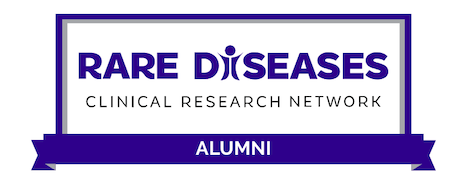NUS1-CDG is an ultra-rare inherited genetic condition caused by genetic changes (variants) in the NUS1 gene. This gene helps the body make a substance called dolichol, which is important for attaching sugar chains to proteins, a process known as N-linked glycosylation. This sugar-adding step is essential for proteins to work properly. When dolichol is missing or reduced, glycosylation is disrupted, leading to problems in many organs and systems throughout the body.
Symptoms
Everyone has two copies of the NUS1 gene in their body. When someone has a variant in only one copy of the NUS1 gene, this causes autosomal dominant NUS1-CDG. When someone has a variant in both copies of the NUS1 gene, this causes autosomal recessive NUS1-CDG. These two types of NUS1-CDG have different symptoms.
Autosomal dominant NUS1-CDG is an inherited neurological disorder where patients have developmental delay, epilepsy (myoclonic or generalized), loss of muscle coordination (cerebellar ataxia), tremors, and in some cases, features resembling juvenile-onset Parkinsonism. Most cases of autosomal dominant NUS1-CDG are caused by de novo variants, meaning genetic variants that happened newly in a child, and were not inherited from their parents.
In contrast, the autosomal recessive form of NUS1-CDG reported in only one family to date, is associated with a severe multisystem phenotype and high early mortality.
Diagnosis
Diagnosis of NUS1-CDG usually begins with a blood test called “transferrin isoelectric focusing” which looks at abnormalities in glycosylation on a protein called transferrin. This blood test can be abnormal in NUS1-CDG, showing a type 1 CDG pattern suggesting a problem in N-linked glycosylation. However, this test may be normal or inconclusive in people with autosomal dominant NUS1-CDG. Therefore, genetic testing is essential to confirm the diagnosis. This involves sequencing of the NUS1 gene through a blood or saliva test.
To date, only one family with pathogenic variants on both copies of the NUS1 gene and confirmed glycosylation defects has been reported, establishing the autosomal recessive form of NUS1-CDG (Park et al., 2014). In contrast, around 22 individuals with a pathogenic variant in one copy of the NUS1 gene have been described with dominant neurological features, though most lack biochemical evidence of CDG (Den et al., 2019; Ji et al., 2023; Riboldi et al., 2022).
Treatment and Prognosis
At present, no disease-specific treatment exists for NUS1-CDG. Management is supportive and multidisciplinary, focusing on symptom control and functional optimization. Experimental therapeutic approaches, such as dietary modification or substrate supplementation targeting the dolichol pathway, remain theoretical and have not yet been validated in clinical studies.
The prognosis varies depending on the underlying genetic cause and the severity of clinical presentation.
- Riboldi GM, Edoardo Monfrini, Stahl C, Frucht SJ. NUS1 and Epilepsy-myoclonus-ataxia Syndrome: An Under-recognized Entity? Tremor and Other Hyperkinetic Movements. 2022 Jan 1;12(1).
- Eon Sub Park, Grabińska KA, Guan Z, Viktor Stránecký, Hartmannová H, Kateřina Hodaňová, et al. Mutation of Nogo-B Receptor, a Subunit of cis-Prenyltransferase, Causes a Congenital Disorder of Glycosylation. 2014 Sep 2;20(3):448–57.

